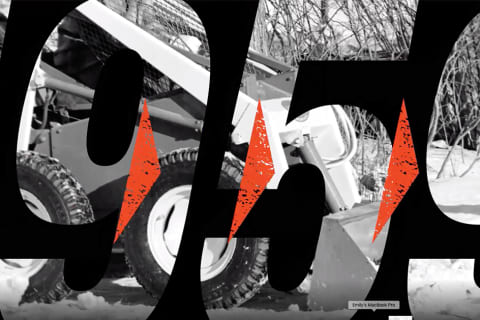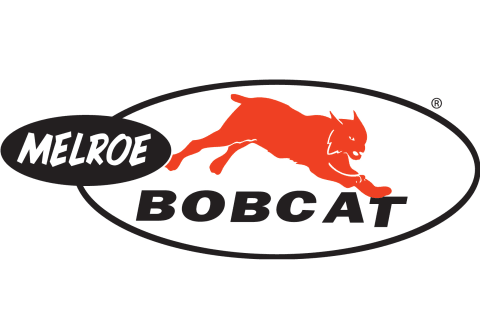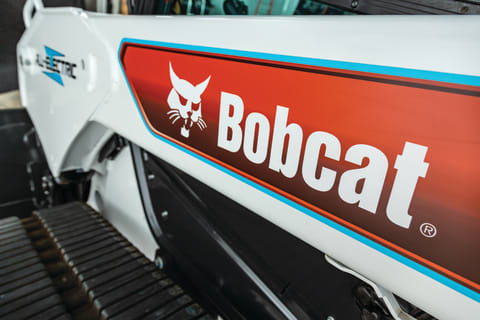- Home
- About Bobcat
- History
- Corporate Timeline
Bobcat Corporate Timeline
A farmer and inventor, Edward Gideon “E.G.” Melroe founded Melroe Manufacturing Company in Gwinner, North Dakota, in 1947. His notable inventions included the Melroe pickup, a combine attachment that would pick up windrows of grain, and the harroweeder, a spring-tooth harrow for weeding row crops. Melroe died in 1955, leaving his sons Lester, Clifford, Roger and Irving, and son-in-law Eugene Dahl, in charge of the business. The prosperous farm implement business changed course in 1958, after the brothers met with inventors Cyril and Louis Keller, from Rothsay, in western Minnesota.
2007 – Present – Doosan Ownership
2018
Doosan Bobcat North America donates five acres of land to the Gwinner, North Dakota. The gift to the City of Gwinner will help transform undeveloped land into a baseball field, benefiting countless families and children in the community.
2017
The West Fargo headquarters is completed. The $9.5 million company headquarters expansion in West Fargo, North Dakota, features a collaborative environment for employees to work in new ways, drive innovation and improve operations. The expansion is part of an overall organizational dedication to maintain Bobcat Company’s global leadership in compact equipment and drive further business growth for the construction equipment brand, defend and strengthen core product offerings, and invest in fundamental competitiveness.
2016
Glenn and Judy Stevens’ breathtaking 225-acre property near Unity, Maine,was bought by Glenn’s grandfather in 1960, and has been a part of their family ever since. See how Bobcat Company helped the couple improve their land so it can be enjoyed by the future generations of the Stevens family.
2015
Nestled into the mountains near the fast-flowing Upper Pack River, John Oxley's property in Sandpoint, ID, is picturesque. It's the perfect location for hiking and wildlife viewing, but riverbank erosion has made it difficult to establish trails and viewing areas. That changed when Bobcat Company stopped by to help out.
2014
A rustic cabin is an ideal place for Keith Fortin to call home. Over the years, he has slowly transformed his mountainside property just outside Whitehall, MT into the sustainable wildlife habitat he’s always wanted. With help from Bobcat Company, he improved upon his vision even further.
2013
Third generation 3600 and 3650 are the first Bobcat utility vehicles with hydrostatic drive, and feature a modular cab with heat and air conditioning. The 3650 with its Multi-Attachment X-Change™ (MAX) system features a hydraulic PTO drive, 500 lb. lift capacity and 2 ft lift height. MAX allows the use of attachments like a snow blower, angle broom, grapple and mower as well as bucket, pallet fork, sprayer and snow blade.
First loaders and excavators equipped with Bobcat-branded, Doosan-built diesel engines, which utilize a non-DPF solution to meet Tier 4 emissions requirements.
2009
Bobcat launches its next generation M-Series loaders and excavators. Over the next five years, the company will replace every loader and every excavator in its lineup.
5610 Toolcat™ utility work machine is introduced. It substitutes a rear Category 1 three-point hitch and PTO in place of the 5600’s rear cargo box, allowing the operation of both front attachments and rear implements. The 5610 retains the other 5600 capabilities, including all-wheel steer and four-wheel drive, a front lift arm and dozens of attachments.
2008
Bobcat celebrates 50 years since the production of its first loader. A special 50th Anniversary Road Show traverses North America, stopping in 25 cities, each hosted by local dealers. The Road Show ends in Gwinner, where employees, retirees – including inventors Louis and Cyril Keller and Cliff Melroe – and locals gather to mark the event.
Bobcat builds its 750,000th loader. With the theme, “How Bobcat Unleashed Me,” Gregory Stone of New York, tells his own life story and how Bobcat® equipment gave him a second chance. The essay wins Stone a special edition Bobcat S205 skid-steer loader, and his story is featured in the celebration video.
2007
Ingersoll-Rand agrees to sell its Bobcat business to Doosan Infracore of South Korea. Doosan is a conglomerate whose businesses include desalination plants, engine manufacturing, industrial machine tools and forklifts. A few years earlier Doosan had acquired the Daewoo brand of heavy construction machinery. Doosan’s prominence in the global construction equipment business suddenly soars with the addition of Bobcat and its worldwide dealer network.
264-page book, “Bobcat: 50 Years of Opportunity,” chronicles the company’s colorful past with hundreds of pictures and dozens of interviews with people who were there when it happened. The book is available at many Bobcat dealers and at BobcatStore.com. Look at it online.
1995-2006 – Rapid Expansion
2006
Diesel powered 2300, the first Bobcat utility vehicle with a quick change RapidLink attachment system, allows the use of a bucket, pallet fork, mower, snow blade and broom.
2004
Second generation 2200 Bobcat utility vehicle, offered both diesel and gas engine options.
American Society of Agricultural and Biological Engineers (ASABE) honors Bobcat with its “Historic Landmark” award for the invention and development of the skid steer loader. The Bobcat loader is one of just a few dozen products to receive this honor, including such notables as the first John Deere plow and Eli Whitney’s cotton gin.
2002
2100 is the first Bobcat entry into the utility vehicle business with a two-person model and a “stretch” version, 2100S.
5600 Toolcat utility work machine, described as a cross between a utility vehicle, pickup truck and skid-steer loader. Designed for the grounds maintenance market, it is the industry’s first hydrostatic utility machine with an all-wheel steer for extreme tight quarters operation. Able to transport two people, the 5600 features an air-conditioned and heated cab, hydraulic dump cargo box, joystick-controlled lift arm, Bob-Tach™ attachment mounting system and some four dozen approved attachments.
2001
Bobcat acquires Czech loader backhoe manufacturer Superstav and its factory in Dobříš, Czech Republic. Bobcat line briefly expands to include loader backhoes, but production is later discontinued. The Czech factory is now building Bobcat loaders and excavators, primarily for the Europe, Middle East and Africa (EMEA) regions.
On February 14, 2001, the company celebrates the production of its 500,000th Bobcat skid-steer loader. Employees, retirees, suppliers, dealers and politicians gather in a staging area at the main assembly building. Guests include inventors Louis and Cyril Keller and the two remaining Melroe brothers, Cliff and Irv. It is the first such reunion of the Bobcat pioneers in more than three decades. Forty-one years after building the first skid-steer loader, the same company is still manufacturing the same product at the same Gwinner factory location -- a rare feat.
2000
“Melroe Company” name changes to “Bobcat Company,” reflecting its primary brand identity. Product focus widens to meet more of customers’ product needs. In 2001, the lineup is still just loaders, excavators and attachments, but two years later the line includes Bobcat telehandlers, loader backhoes, mini-track loaders, utility vehicles and even light construction products.
Bobcat acquires hydrostatic telehandler pioneer Sambron, whose factory was in Pont Château, France.
1998
Melroe Spra-Coupe product line is sold to AGCO Corporation.
Bobcat acquires Palm Attachment Sales of Grove City, Minnesota, which had been making skid-steer loader attachments since the mid-1980s. Bobcat later moves that manufacturing operation to nearby Litchfield, in west central Minnesota.
1995
Clark Equipment Company is sold to Ingersoll Rand Company of Woodcliff Lake, New Jersey. Bobcat is included in the transaction, along with the Clark axle business, and two recent Clark acquisitions: Club Car golf cars and utility vehicles and Blaw Knox pavers.
1969-1994 – Clark Equipment Company
1986
Melroe acquires trencher business from Midmark and enters the compact excavator business with OEM products.
1980
Bobcat celebrates the production of its 100,000th skid-steer loader.
The first welding robot is installed in Gwinner factory to make buckets.
After the Recession, Melroe sells off its agricultural products and closes three factories. More Bobcat products move to Bismarck; Gwinner plant expands.
1979
Clark’s Melroe Division sales top $210 million, 2,100 on payroll.
1975
Production of large-frame Bobcat 974/975 and 825 models expands into a former Clark trailer factory in Spokane, Washington. The plant closes in 1980 and production moves back to North Dakota.
1972
With new money from Clark, the Melroe Division of Clark buys Kirschmann Manufacturing Company of Bismarck, North Dakota, and its Spra-Coupe self-propelled crop sprayer business.
1970
“Bobcat is a Farm Boy at Heart” film entertains as it shows loader farm applications. The film intro briefly tells the history of Melroe agricultural products and how the Bobcat loader came to be.
1969
Sales top $25 million. Growing any larger requires Melroe brothers to either take their company public or find a buyer. In the end, they agree to sell to Clark Equipment Company of Buchanan, Michigan, a manufacturer of Clark forklifts, Michigan wheel loaders, road graders, axles and transmissions. Clark had tried and failed to build its own skid-steer loader, so buying Melroe is a logical alternate choice.
1962-1968 – Bobcat Era
1968
Gwinner manufacturing complex expands to eight buildings.
1967
Melroe brothers expand their agricultural product line and purchase Reiten Manufacturing of Cooperstown, North Dakota, a maker of moldboard plows. Melroe product family now includes windrow pickup, harroweeder, chisel plow and Bobcat loader. By this time, Bobcat sales account for 65% of the company’s business.
In a rare television interview, Cliff and Roger Melroe take viewers inside the Gwinner factory. The brothers tell of the company’s rapid growth, and the opportunity provided by their exciting new product – the Bobcat loader.
1966
“Bobcat Square Dance” film spreads the Bobcat story in an entertaining way, using music and four dancing Bobcat machines to demonstrate Bobcat maneuverability. The film was often shown on the Captain Kangaroo show in the 1960s and 1970s.
1965
Melroe distribution expands to Europe with Luff & Smith license agreement to manufacture Bobcat loaders in Southampton, England. After two years, the agreement ends and a permanent Melroe Ltd. office is set up in Southampton.
1964
Builds 4000th windrow pickup in Gwinner. Employees gather to celebrate.
1000th Bobcat loader built in Gwinner.
1963
Melroe Manufacturing Company sales hit $6 million, 200 on payroll.
1962
After nearly exiting the loader business, Melroe redesigns and rebrands its skid-steer loader, introduced as model M440 “Melroe Bobcat” skid-steer loader with familiar white and red color scheme.
1929-1960 - Melroe Family & Keller Brothers
1960
M400, first 4-wheel-drive skid-steer loader launches. Melroe contracts with Farmhand to reach broader agricultural market.
Melroe Manufacturing Company sales hit $1 million, 100 employees on payroll.
1959
Next generation M200 Melroe self-propelled loader introduced.
1958
Melroe brothers introduced to Kellers, who join the company to design and produce Melroe self-propelled loader, model M60.
1957
Keller brothers -- Louis and Cyril -- of Rothsay, Minnesota, invent three-wheeled loader.
1955
E.G.’s new spring tooth harrow with folding drawbar introduced, named the Melroe harroweeder. The Melroe family business is featured in the Fargo Forum newspaper article.
After the passing of E.G. Melroe, son Cliff Melroe named president of Melroe Manufacturing Company, running the company with his three brothers and brother-in-law.
1952
E.G.’s new spring tooth harrow with folding drawbar introduced, named the Melroe harroweeder. The Melroe family business is featured in the Fargo Forum newspaper article.
1947
E.G. and sons -- back home after WWII service -- open Gwinner factory to manufacture new design windrow pickup. When service station and schoolhouse sites proved too small, they build factory building in 1948.
1937
E.G. and family members build a few pickup attachments for neighbors. In 1939 he sells pickup design to John Deere for $5,000 to pay hospital bills after heart attack and leg amputation.
1929
Edward Gideon (E.G.) Melroe invents the windrow pickup on his Gwinner, North Dakota, farm.
Explore More About Bobcat's History

Product Timeline
Learn how Bobcat products evolved and why Bobcat leads the compact equipment industry.

